
Special Circumstances Made Easy
Family trees, also known as genograms, provide information as to how people are related and show patterns in a family. Your family tree could include information about your medical history, conflicts, spirituality and more. Drawing a family tree might seem simple unless your family includes special circumstances such as divorce, remarriage, and children born or adopted by different partners. Using the correct symbols and lines helps create a family tree that represents everyone and accurately displays family relationships.
Drawing Women and Men
Women are typically represented by a circle, while men are depicted with a square. Sometimes, gender is unknown because of androgynous names or personal gender-identity dynamics. When you are not sure which gender to draw for someone, use a triangle to represent them on the family tree.
Drawing Marriages
Marriages are drawn as a solid horizontal line that connects two adults on the same level of a genogram. Sometimes, people document the marriage date just above or below the line connecting the spouses. Other important information could also be listed, such as the city, state and country where the marriage took place. For even more detail, include a small photo next to each person's family tree symbol.
Drawing Separation and Divorce
When two married people become separated or divorced, it's important to show it on the line connecting them. Separation is normally indicated by one slash through the line connecting them, while divorce is indicated by two slashes through the line. When multiple marriages are present, sometimes the lines between different spouses and family members are color coded to make the family tree easier to read.
Drawing New Relationships and Remarriage
Divorce is often followed by new relationships and remarriages. To include a new partner on the family tree, extend the line past the first spouse to create a space for the second or third partner. Romantic partners who are not married but are living together or have children together are connected by a dotted line instead of a solid line. New spouses are marked by a solid line with no dashes or slashes. The more partners and spouses that are included in a family tree, the more helpful color coding and dates are in keeping everything in order.
Drawing Children
Children are drawn on the family tree using a vertical line that goes from the spouse who gave birth to or who adopted the child. Biological children are drawn with a solid line that might be color coded when children have resulted from multiple marriages. Adoptive children are depicted with a dashed line, while foster children are represented by a dotted line. Occasionally, a family tree lists the year of birth or birthday for each child above their genogram symbol.
Related Articles

How to Make a Genogram Chart
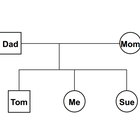
How to Draw Genograms

What Are the Genogram Symbols?

How to Do a Genogram

Family Tree Rules

How to Find Twins on Pedigree Charts
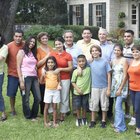
How to Construct a Kinship Diagram

How to Create a Family Tree That ...

How to Make a Family Tree With Ex ...
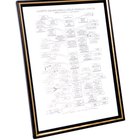
How to Make a Free Genogram
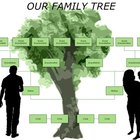
How to Make a Family Tree for the 5th ...

The Difference Between First and Second ...

The Standard Size for Wedding ...

How to Address Invitations With No ...

Blended Family Ceremony Ideas
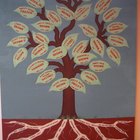
How Are Second Cousins Related?

Etiquette for Save the Date Envelopes

What Is a First-Degree Relative?

Five Concepts of Interpersonal ...

The Effects of Divorce & Introducing a ...
References
Tips
- Several computer programs are available for creating family trees, and they all work differently. Explore the help section or user's guide for your particular software to learn how to record marriage and divorce data in your digital family tree.
Writer Bio
Anne Kinsey is a Certified Trauma Recovery Coach and missionary, residing in rural North Carolina. She is the founder of Love Powered Life, a nonprofit organization with the mission of creating loving community for trafficking survivors and their families. Anne has enjoyed writing for publications like Working Mother, the San Francisco Chronicle, the Houston Chronicle, Bizfluent and Career Trend. She resides in rural North Carolina with her husband, three children and a house full of furry friends.